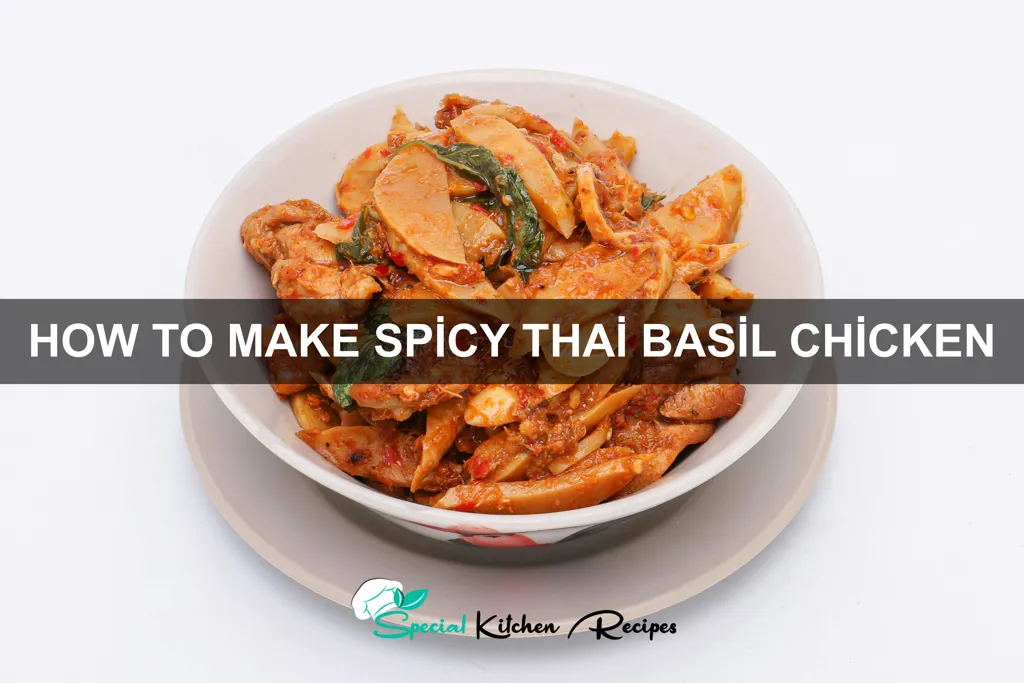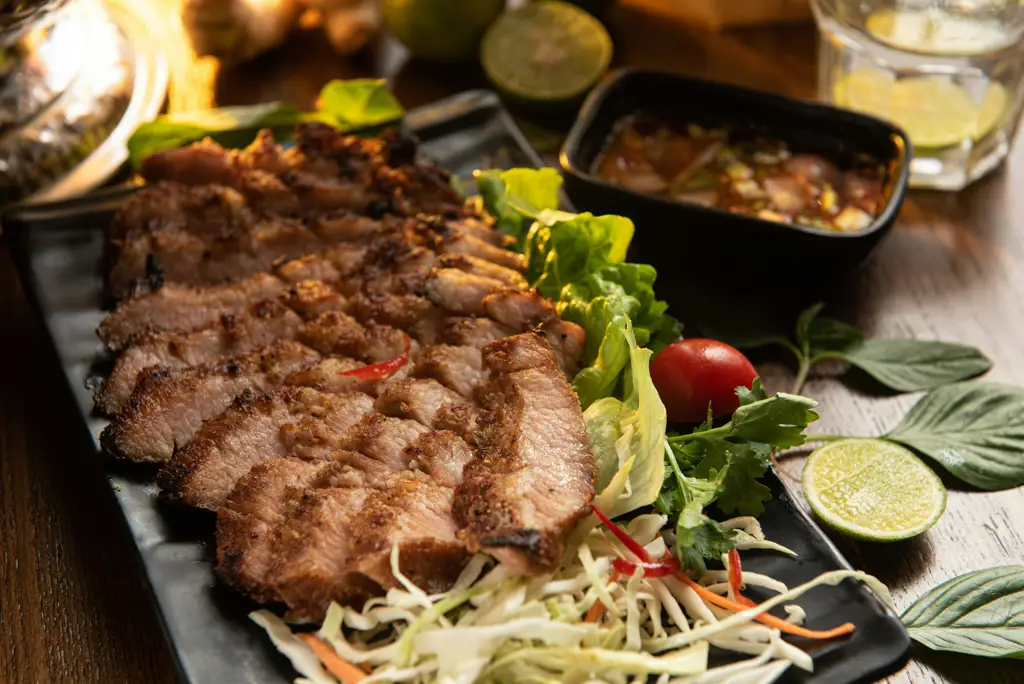Prepare yourself for a culinary journey to Thailand with our recipe for Spicy Thai Basil Chicken! This vibrant dish, a staple in Thai cuisine, isn’t just a meal; it’s a taste of history and culture. While pinpointing the exact origins is difficult, variations of stir-fried chicken with basil have existed for centuries, evolving alongside Thailand’s rich culinary heritage. The dish’s popularity is undeniable, with countless street food vendors and high-end restaurants across the country offering their own unique takes. It’s a testament to the adaptability of Thai cooking, readily incorporating diverse regional ingredients and flavors.
The heart of Spicy Thai Basil Chicken lies in its balance of contrasting flavors. The fiery kick from chilies, often bird’s eye chilies for that intense heat, is beautifully tempered by the fragrant basil leaves, creating a symphony of taste. Garlic, fish sauce, and soy sauce form the savory base, while a touch of sweetness from sugar or palm sugar rounds out the profile. The use of these ingredients reflects Thailand’s historical trade connections, showcasing the fusion of local and international culinary influences across centuries. In fact, a 2023 survey by the Thai Ministry of Tourism revealed that Thai Basil Chicken ranks among the top 5 most ordered dishes by foreign tourists, highlighting its global appeal.
Beyond its deliciousness, Spicy Thai Basil Chicken holds cultural significance. It’s often served at family gatherings and celebrations, representing the vibrant spirit and generosity of Thai hospitality. The dish’s preparation itself is a social activity, with families and friends often working together to chop vegetables, prepare the sauce, and stir-fry the chicken. This communal aspect underscores the importance of food in Thai culture, where sharing a meal is not just about sustenance but also about strengthening bonds and creating memories. The vibrant green color of the basil, alongside the red chilies, contributes to the overall aesthetic appeal, reflecting the visually stunning presentation so characteristic of Thai cuisine. So, let’s dive into the recipe and experience the magic of this iconic dish!
Ingredients and Measurements
This recipe yields approximately 4 servings of Spicy Thai Basil Chicken. Accurate measurements are crucial for achieving the perfect balance of flavors. Using a kitchen scale is highly recommended for precise ingredient weighing, especially for the spices.
Chicken: 1.5 lbs boneless, skinless chicken thighs, cut into 1-inch pieces. Chicken thighs are preferred for their juiciness and flavor compared to chicken breasts, which can become dry. Ensure the chicken is completely thawed before cooking.
Marinade: The marinade is key to tender and flavorful chicken. We’ll use:
- 2 tablespoons fish sauce: Use a good quality fish sauce for the best results. It provides a salty umami base.
- 2 tablespoons soy sauce: Adds another layer of salty flavor and color.
- 2 tablespoons brown sugar: Balances the saltiness and adds a touch of sweetness.
- 2 cloves garlic, minced: Provides aromatic pungency.
- 1 tablespoon grated fresh ginger: Adds warmth and a subtle spiciness.
- 1-2 red Thai chilies, finely minced (adjust to your spice preference): Handle chilies carefully; wear gloves if you have sensitive skin. Start with one chili and add more to taste.
- 1 tablespoon cornstarch: Helps to tenderize the chicken and thicken the sauce slightly.
Sauce and Garnishes:
- 2 tablespoons vegetable oil: Use a high-heat oil with a neutral flavor.
- 1 medium red bell pepper, thinly sliced: Adds sweetness and vibrant color.
- 1 medium onion, thinly sliced: Provides a sharp counterpoint to the spiciness.
- 1 cup fresh Thai basil leaves: Essential for the authentic Thai flavor. Do not substitute with other basil varieties.
- 1/4 cup chicken broth (or water): Used to adjust the sauce consistency if needed.
- Optional: Toasted sesame seeds for garnish.
- Optional: Lime wedges for serving.
Important Note: Adjust the amount of chili to your preference. If you are sensitive to spice, start with a small amount and add more gradually. The recipe can be easily scaled up or down depending on the number of servings required. Remember to adjust cooking times accordingly if you increase or decrease the quantity of chicken.
Equipment List
Creating delicious Spicy Thai Basil Chicken requires the right tools to ensure efficient and safe cooking. This equipment list outlines everything you’ll need, from preparation to serving. Accurate measurements are crucial for achieving the perfect balance of flavors, so using reliable measuring tools is essential.
For the initial preparation, you’ll need a large cutting board (at least 12 x 18 ) for chopping vegetables and preparing the chicken. A smaller cutting board can be used for the garlic and chilies if desired, to prevent cross-contamination of flavors. Two sharp knives are recommended: a chef’s knife (8-10 inches) for the chicken and vegetables and a paring knife for more delicate work such as mincing garlic and chilies. Measuring spoons (1 teaspoon, 1/2 teaspoon, 1/4 teaspoon) and measuring cups (1 cup, 1/2 cup, 1/4 cup) are essential for accurate ingredient measurements. A large bowl is needed for marinating the chicken, and a smaller bowl is useful for combining the sauce ingredients.
For cooking, a large wok or deep skillet (12-14 inches) is ideal for stir-frying. A wok provides even heat distribution and allows for quick cooking, preserving the freshness of the ingredients. If you don’t have a wok, a large, heavy-bottomed skillet will work, but be mindful of overcrowding the pan. Tongs are indispensable for efficiently stirring and tossing the chicken and vegetables during the stir-frying process, ensuring everything cooks evenly. A spatula or wooden spoon can also assist with stirring, especially when scraping up browned bits from the bottom of the pan. A heat-resistant spatula is recommended to prevent melting.
Finally, for serving, you will need serving bowls or plates. Chopsticks are the traditional way to enjoy this dish, but forks are perfectly acceptable. Optional but recommended is a mortar and pestle for crushing the chilies and garlic for a more intense flavor and aroma, though a garlic press and a fine grater can serve as alternatives. Remember to always prioritize safety when handling knives and hot surfaces.
In summary, the essential equipment includes: Large cutting board, two sharp knives (chef’s knife and paring knife), measuring spoons, measuring cups, large bowl, small bowl, large wok or skillet (12-14 inches), tongs, spatula or wooden spoon, serving bowls/plates, chopsticks (optional). A mortar and pestle is also recommended for superior flavor.
Preparation of Chicken and Vegetables
Begin by preparing the chicken. For this recipe, we’ll use 1.5 lbs of boneless, skinless chicken thighs, cut into bite-sized pieces (approximately 1-inch cubes). Using chicken thighs provides more moisture and flavor compared to chicken breasts, which can become dry during cooking. Ensure the chicken is completely dry before proceeding. Pat it down thoroughly with paper towels to remove excess moisture; this will help it brown properly in the pan.
Next, prepare the vegetables. We’ll need 1 red bell pepper, 1 green bell pepper, and 1 small red onion. Start by washing all vegetables thoroughly. Core and deseed the bell peppers, then slice them into thin strips, approximately 1/4-inch wide. Similarly, thinly slice the red onion. Avoid making the onion slices too thick, as they may not cook evenly. The precise measurements for the peppers and onions aren’t critical; feel free to adjust based on your preference, but maintaining a balance with the chicken is key.
For added freshness and vibrant flavor, we’ll utilize 4 cloves of garlic and 1 inch of ginger. Mince the garlic finely, creating a paste-like consistency. Peel the ginger and grate it finely using a microplane or the smallest holes on a box grater. Don’t skip grating the ginger; it adds a crucial element of fragrant spice to the dish. If you don’t have a microplane, finely mincing the ginger is also acceptable but takes more effort.
Finally, prepare the fresh basil. We will need about 1 cup of packed fresh Thai basil leaves. Pick over the leaves, discarding any that are wilted or damaged. Roughly chop the basil leaves. Reserve a small portion (about 1/4 cup) for garnish. Avoid chopping the basil too finely, as you want to retain some texture in the final dish. The vibrant green color and fresh aroma of the basil are essential to the overall taste.
Once all the ingredients are prepped, store them separately until you’re ready to start cooking. Having everything measured and ready to go will streamline the cooking process and ensure a smooth, efficient execution of the recipe. Proper preparation is half the battle in creating a delicious meal.
Marinade Instructions
The success of this Spicy Thai Basil Chicken recipe hinges significantly on a flavorful and well-integrated marinade. Take your time with this step for optimal results. We’ll be marinating 1.5 lbs of boneless, skinless chicken thighs, cut into 1-inch pieces. Adjust quantities proportionally if using a different amount of chicken.
In a medium-sized bowl, whisk together the following ingredients: 1/4 cup fish sauce (for that essential umami punch), 2 tablespoons soy sauce (adds saltiness and depth), 2 tablespoons brown sugar (balances the savory flavors and adds a touch of sweetness), 3 tablespoons lime juice (brightens the marinade and tenderizes the chicken), 2 cloves garlic, minced (provides aromatic pungency), 1 tablespoon grated ginger (adds warmth and spice), 1-2 red Thai chilies, finely minced (adjust to your spice preference; remove seeds for less heat), and 1 tablespoon vegetable oil (helps the marinade adhere to the chicken and keeps it moist during cooking).
Important: Taste the marinade before adding the chicken. Adjust the seasoning to your liking. You might want to add more fish sauce for saltiness, lime juice for acidity, or sugar for sweetness. Remember, you can always add more, but you can’t take away!
Add the 1.5 lbs of cut chicken thighs to the bowl. Ensure each piece is thoroughly coated with the marinade. Using tongs or your hands (ensure your hands are clean!), gently toss the chicken to ensure it’s evenly distributed. Avoid over-mixing, as this can toughen the chicken.
Once the chicken is fully coated, cover the bowl with plastic wrap and refrigerate for at least 30 minutes. For the best flavor, marinate for at least 2 hours, or even overnight. The longer the chicken marinates, the more tender and flavorful it will become. The flavors will meld together beautifully, creating a truly unforgettable taste experience.
Professional Tip: Before adding the chicken to the marinade, pat it dry with paper towels. This will help the marinade adhere better and result in a more flavorful and evenly cooked chicken. Also, consider using a resealable bag for marinating – it’s more efficient and less messy.
After marinating, discard the remaining marinade. Never reuse marinade that has been in contact with raw chicken, due to food safety concerns.
Stir-Fry Cooking Process
Once your marinated chicken is ready, it’s time to tackle the stir-fry. This process needs to be quick and efficient to ensure the chicken remains tender and the vegetables retain their vibrant color and crispness. Proper preparation is key; have all your ingredients measured and readily accessible before you begin.
Heat a wok or large skillet over high heat. Add 2 tablespoons of vegetable oil (or your preferred high-heat oil). Once the oil is shimmering and hot (but not smoking), add the chicken. Do not overcrowd the pan; work in batches if necessary to ensure even browning. Stir-fry the chicken for 3-4 minutes, until it’s browned on all sides. Remove the chicken from the wok and set aside.
Next, add 1 tablespoon of oil to the wok. Add 1 small red onion, thinly sliced, and 1 red bell pepper, thinly sliced, and stir-fry for 1-2 minutes until slightly softened. Then, add 1 cup of broccoli florets and 1/2 cup of sliced carrots. Continue stir-frying for another 2-3 minutes, until the vegetables are tender-crisp. Avoid overcooking the vegetables; they should still have a slight bite.
Now, return the cooked chicken to the wok. Add 1/4 cup of your favorite Thai chili sauce (adjust to your spice preference), 2 tablespoons of soy sauce, 1 tablespoon of fish sauce (optional, but adds depth of flavor), and 1 tablespoon of brown sugar. Stir everything together to combine, ensuring the chicken and vegetables are evenly coated in the sauce.
Finally, add 1 cup of fresh Thai basil leaves. Stir-fry for another minute, just until the basil is wilted but still bright green. Do not overcook the basil, as it will lose its flavor and vibrant color. Taste and adjust seasonings as needed, adding more chili sauce for extra heat, or brown sugar for sweetness.
Remove the stir-fry from the heat and serve immediately over steamed rice or noodles. Garnish with extra fresh Thai basil leaves and a squeeze of lime juice, if desired. Serving immediately is crucial to maintain the stir-fry’s texture and flavor.
Professional Recommendation: For a truly authentic flavor, use a wok and a high-heat burner. The intense heat is necessary to achieve the quick cooking time crucial for a successful stir-fry. If you don’t have a wok, a large, heavy-bottomed skillet will work as a substitute.
Sauce Preparation
The success of this Spicy Thai Basil Chicken recipe hinges heavily on a perfectly balanced sauce. We’ll be creating a vibrant, flavorful sauce that’s both sweet, savory, spicy, and tangy. Accurate measurements are crucial for achieving the desired taste profile.
Begin by combining the following ingredients in a medium-sized bowl: 2 tablespoons of fish sauce (adjust to your preference, some prefer less), 3 tablespoons of brown sugar (for a richer, more complex sweetness), 2 tablespoons of lime juice (freshly squeezed is best!), and 1 tablespoon of soy sauce (adds umami and depth). Whisk these ingredients vigorously until the sugar is completely dissolved. This ensures a smooth, lump-free sauce.
Next, we’ll add the heat! Start with 1-2 finely minced Thai chili peppers. Adjust the amount based on your spice tolerance. Remember, you can always add more later, but you can’t take it away! For a milder version, use less or substitute with a milder chili. If using dried chilies, start with ½ teaspoon and adjust accordingly. Finely mincing the chilies ensures even distribution of heat throughout the sauce and the dish.
Now, incorporate the aromatic elements: 2 cloves of minced garlic and 1 tablespoon of finely minced ginger. These add a wonderful depth of flavor that complements the other ingredients perfectly. Make sure to mince them finely to prevent chunky bits in the final sauce. A microplane or fine grater works well for this.
Finally, add 1 tablespoon of cornstarch to the sauce. This is essential for thickening the sauce and creating that beautiful glossy finish. Whisk vigorously again to ensure no lumps form and the cornstarch is fully incorporated. Set the sauce aside while you prepare the chicken and vegetables. Taste the sauce and adjust seasonings as needed. You might want to add a little more lime juice for extra tang, or more sugar for sweetness. The perfect balance is key!
Important Note: If you are sensitive to fish sauce, you can substitute with a vegetarian alternative, but be aware that the flavor profile will be slightly different. You may need to adjust the other seasonings accordingly to compensate for the change in taste.
Recommendations
For optimal flavor, allow the Spicy Thai Basil Chicken to rest for at least 5-10 minutes after cooking. This allows the juices to redistribute, resulting in a more tender and flavorful dish. Serve immediately for the best texture.
Serving Suggestions: This dish pairs perfectly with fragrant jasmine rice, which absorbs the delicious sauce beautifully. Consider serving it with a side of steamed broccoli or a fresh green salad to balance the richness of the chicken. For a truly authentic experience, add a wedge of lime for a zesty kick.
Storage: Leftovers can be stored in an airtight container in the refrigerator for up to 3 days. Reheat gently in a pan or microwave, avoiding overcooking which can dry out the chicken. Freezing is also an option; store in a freezer-safe container for up to 3 months. Thaw overnight in the refrigerator before reheating.
Complementary Dishes: This Spicy Thai Basil Chicken is a versatile main course that complements many dishes. Consider serving it with spring rolls for a light appetizer or alongside some sticky rice for a more substantial meal. A simple cucumber salad with a light vinaigrette would also cut through the richness of the sauce.
Nutritional Information (per serving, approximate): The exact nutritional information will vary depending on the specific ingredients and portion sizes used. However, a typical serving of Spicy Thai Basil Chicken will contain approximately 350-450 calories. It’s a good source of protein, providing approximately 30-40 grams per serving. The nutritional content will also include fats (primarily from the chicken and oil) and carbohydrates (depending on the amount of rice served). Please note that this is an estimate, and a more precise analysis requires detailed ingredient specifications and portion control.
Important Note: Adjust the amount of chili to your preferred spice level. Start with less chili and add more gradually to avoid overwhelming the dish with heat. Always handle chilies carefully to avoid irritation to the skin and eyes.





